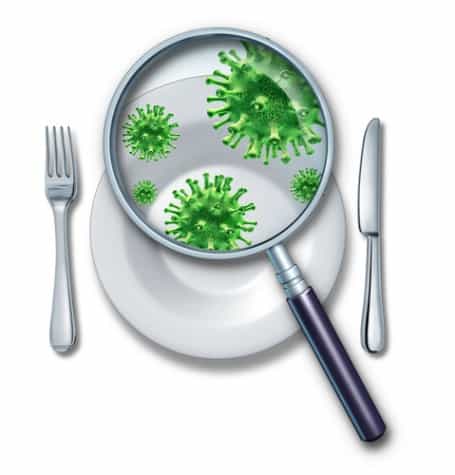HOW we prep and store our food is just as important as WHAT we prep for our health. Food poisoning is no fun and most of us can vividly recall if we’ve fallen victim! So many of the pathogens I find disrupting my client’s health in a variety of ways are linked to nasty bugs that invade the body through food. Foodborne illness can be serious. If the food you eat is not handled properly, your risk for getting food poisoning increases, and let’s be honest: no one wants food poisoning. NO ONE.
Although we don’t have full control over how our food is handled before it reaches our kitchens, we can take some precautions to minimize and prevent harmful bacteria, like Salmonella, E. Coli, Listeria and Campylobacter, from taking over the healthy meals we prepare each week. Let’s look at five basic yet super serious food safety mistakes you might be making in your kitchen and how to avoid them.
1. You don’t cook your meat long enough.
Solution: Use a meat thermometer.
The best way to ensure your meat and seafood is cooked all the way through is to use a meat thermometer. Digital thermometers are inexpensive to buy and can quickly tell you the internal temperature of your meat. Yep, that means no more cutting into the middle of a chicken breast to see if it’s still pink! Always check the temperature of your meats and seafood in the center, at the thickest part of the cut. To keep the temperature accurate, ensure the thermometer doesn’t touch the bone. If you are cooking multiple pieces of meat, be sure to check the internal temperature of each piece separately. Click here to learn more about safe cooking temperatures.
2. You let your cooked food sit at room temperature for too long.
Solution: Use the two hour rule.
Once cooked, food should only sit at room temperature for a maximum of two hours before it is transferred to the fridge. If left any longer, dangerous bacteria can start to grow and quickly contaminate your food.
3. You don’t wash your fruits and vegetables.
Solution: Wash your fruits and vegetables!
You should be washing all of your fruits and vegetables, even if they are organic! Fresh fruits and vegetables are the cause of 46% of food poisoning cases and leafy green veggies may account for more than any other foodborne illness. Remember the big E. coli outbreak in 2006 from bagged “washed” spinach?
Expensive fruit and veggie cleaners aren’t necessary as a simple wash with water can remove dirt, bacteria and even different pesticides from your produce. Gently rub fruits and veggies under running cold water, allow water to run over them for 1-2 minutes. Don’t use soaps, detergent or other cleaning products as these can leave their own residue and may even change the flavor.
There are two simple methods for removing pesticide residue as well. This recent study shows that soaking produce in a baking soda solution is tan effective way to remove pesticide residues. Another is using a 1:3 solution of vinegar and water – either soak or gently rub fruits and vegetables then thoroughly rinse under cool water to remove any residual vinegar flavor.
4. You thaw meats and frozen foods on the counter.
Solution: Thaw your meats and frozen foods in the refrigerator.
Um, hello. We see you leaving that package of frozen chicken on the counter for several hours. Stop that! The safest way to thaw frozen foods is on a plate in the refrigerator on the bottom shelf to prevent contamination of other items. Avoid thawing meats and frozen foods at room temperature. Once thawed, it is best to cook the food immediately.
Now let’s face it – we don’t always have 24 hours to thaw our food, right? In this case, you can safely defrost your food faster in a cold water bath. You can also safely cook your foods from frozen but remember that it will take 50% longer than if you were cooking the food from a thawed state. Time to get out that digital thermometer 🙂
5. You rinse your meat with water before cooking it.
Solution: Do not rinse your meat!
Rinsing chicken and other meats before cooking is not recommended as the bacteria on the surface of raw meats can be easily be spread around the kitchen through water splashes, which increases the risk of contaminating other foods you’re preparing. Instead of washing your meat, simply transfer it straight from the package to the pan to reduce the spread of bacteria. Cooking your poultry and meat to a safe internal temperature will kill off any bacteria that may be present on the surface of the meat.
These are just a few simple tips that can help keep you and your family safe from pesky bugs!


